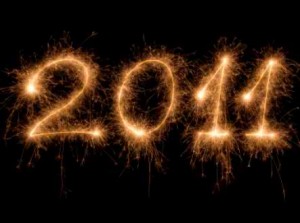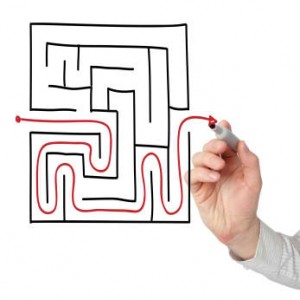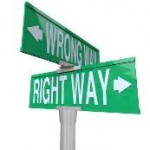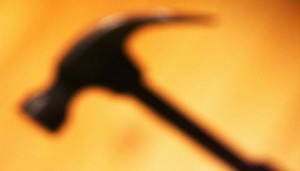 Welcome to the New Year! If you’re a “resolutions” kind of person, this week’s posts may give you a line item that’s all about New for your list. New ideas are appropriate to both this calendar moment and to our roles as project managers, where solving problems often requires fresh thinking and our businesses ask for ideas that will put them ahead of the competition. In this frame of mind, I suggest that we consider who we are as innovators, perhaps setting a goal this year to understand how we each grapple with the New and what we can do to progress our capabilities on our own and together. (Now’s a great time to grab a coffee, so you feel like taking a bold step!)
Welcome to the New Year! If you’re a “resolutions” kind of person, this week’s posts may give you a line item that’s all about New for your list. New ideas are appropriate to both this calendar moment and to our roles as project managers, where solving problems often requires fresh thinking and our businesses ask for ideas that will put them ahead of the competition. In this frame of mind, I suggest that we consider who we are as innovators, perhaps setting a goal this year to understand how we each grapple with the New and what we can do to progress our capabilities on our own and together. (Now’s a great time to grab a coffee, so you feel like taking a bold step!)
Let’s start by asking ourselves: How do I approach new and difficult challenges? What’s my innovation mindset? Does it seem different from my colleagues’? Will we be able to innovate well together if that’s the case?

Having spent 25 years as an engineer, designer and innovator, often facilitating brainstorms and decision-making sessions, it’s many times that I’ve personally sensed great differences in how the people in the room pursue and react to new ideas. I used to chafe with disappointment when enthusiasm for what I thought was “REAL innovation” was less than unanimous in a group.
Picture me encouraging a group with, “It’s never been seen before!” while a few in the room say the same thing but from a different perspective. They’re thinking, “Well, then, maybe we shouldn’t we be doing it?!”
More recently I understood that, unless the deck is stacked (all one type of people in the room), there will always be differences in the level and type of engagement each person brings to the different phases of innovation. We have to expect that the people around the table will generate and follow through on potential solutions in very different ways. It turns out that I am tuned for “having different ideas” and “doing things no one else is doing,” which is just one of four innovation types described in a recent research study (Introduction to Type and Innovation; www.cpp.com). Collaborating in an organization with all four types can balance your efforts and be a good thing for getting new solutions out the door.
My type (we are 12% of the population) is prone to present complex thoughts instead of simplifying (just look at these long sentences!); thinks that there needs to be a certain rigor to the innovation process (oh! I thought everyone agreed with that!); and is advised to work at improving how they get buy-in from others (won’t they just “get it” and go along?). Along with a page of other descriptions and tips, I felt pegged far more accurately than by, um, my birthday horoscope even!
I do rail against personality typing at times, finding it hard to pin myself down to one characterization. But, even so, I found this type-guide helpful in a broader sense, when I considered that I work in different modes depending on what’s needed at the time. So I found further coaching by associating myself with more than one type… just a little rule-bending for the greater good.
The authors, Killen (HR consultant) and Williams (IT and innovation), grounded their 500-participant study in the globally recognized Meyers-Briggs personality assessment. If you know your M-B type, or guesstimate it, then it makes finding yourself in their Innovation Type report all the more interesting. They offer descriptions and innovation coaching tips for all 16 M-B types. These 16 personality types settle into four innovation types.
You may be attracted to one of these four:
Refining Ideas : Doing Things Better (aligns with “SP” types, sensing/perceiving)

Different Ideas : Doing Things No One Else Is Doing (“NP” types, intuitive/perceiving)
![]()
Adopting Ideas : Doing Things Others Are Doing (“NJ” types, intuitive/judging)
Efficiency Ideas : Doing the Right Things and Doing Them the Right Way (“SJ” types, sensing/judging)

Working in one of these areas may be more appealing to you, while the other areas could be more difficult or less interesting. If you build an innovation organization with people from each type, applying their strengths at the right time during product development and understanding each others’ perspectives, then the innovation process can be smoother and quicker. Even more so if there is awareness of the variety in the team’s strengths.
Let’s go further into that in the next post.





Thanks for this extremely interesting post, Chris! This is a valuable tool for building patience with others on teams with different kinds of members. Often we perceive different as deficient. In fact, diversity of perspectives and approaches is vital to team effectiveness. Imagine a baseball team with 9 terrific pitchers – you’d never win! And yet other people’s preferred strategies can be extremely irritating at times if we perceive ourselves as “right” and them as “wrong”. While there are some incompetent jerks out there intent on little more than their own personal self-agrandizement, most people on our teams are worthy partners committed to helping the team succeed. My resolution this year is to welcome differently-gifted people more warmly into my world.
Hi Chris,
Great post. I have done similar work with the Enneagram, which can describe innovation for each of the 9 Enneagram types. I agree that it is best to start with understanding your own type, appreciating other’s type and realizing that the sum of all styles can be extremely powerful in innovation.
Peter Savich’s “Personality and the Brain” connects the Enneagram and the brain and even explains why some of us like to approach problems by breaking the problem down in to small parts and some of us prefer to approach problems from the big, complex picture point of view. (I am the latter.) Fascinating stuff.
Wishing you the very best with all you 2011 resolutions!